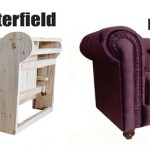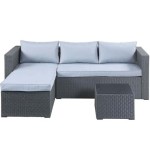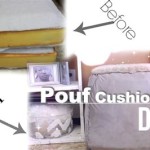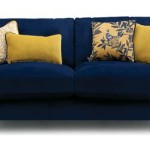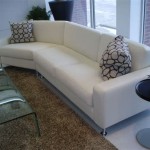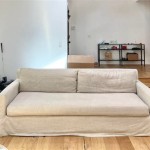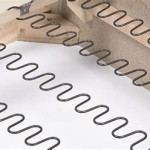Best Materials for Outdoor Sofas: A Comprehensive Guide
Selecting the right material for an outdoor sofa is a crucial decision that significantly impacts its longevity, comfort, and overall aesthetic appeal. Exposure to the elements, including sunlight, rain, humidity, and temperature fluctuations, demands materials that are specifically engineered to withstand such conditions. The ideal material balances durability, style, ease of maintenance, and cost-effectiveness, adapting to diverse climates and usage patterns. This article explores the best materials for outdoor sofas, providing a comprehensive understanding of their properties, advantages, and disadvantages to aid in informed decision-making.
The outdoor furniture market offers a wide array of material choices, each possessing unique characteristics. Understanding these differences is paramount to selecting a sofa that will provide years of enjoyment. The primary considerations when choosing an outdoor sofa material include:
- Weather Resistance: The ability to withstand moisture, UV radiation, and extreme temperatures.
- Durability: Resistance to wear and tear, including scratches, dents, and fading.
- Comfort: A material's texture and feel, contributing to an enjoyable seating experience.
- Maintenance: The ease with which the material can be cleaned and maintained, preventing damage and prolonging its lifespan.
- Aesthetics: The material's visual appeal and its ability to complement the overall outdoor space.
- Cost: The price point of the material, balancing initial investment with long-term value.
Understanding the Strengths of Teak Wood
Teak is a hardwood renowned for its exceptional durability and natural resistance to the elements. It is derived from the teak tree (Tectona grandis), native to Southeast Asia. Teak's high oil content makes it naturally resistant to water, insects, and decay, making it an ideal choice for outdoor furniture. This inherent resistance allows teak to withstand exposure to rain, sunlight, and humidity without significant deterioration. Over time, untreated teak will develop a silver-gray patina, a characteristic often considered aesthetically pleasing. However, if the original color is desired, teak can be periodically treated with teak oil or sealant.
The density and strength of teak make it highly durable, capable of withstanding heavy use and resisting scratches and dents. Teak furniture can last for decades with proper care, representing a long-term investment in outdoor comfort. Its natural beauty and warm tone add a touch of elegance to any outdoor space. Teak is a relatively low-maintenance material. Regular cleaning with soap and water is typically sufficient. However, it's important to note that teak is a relatively expensive material compared to other options like aluminum or synthetic wicker.
Environmentally, the sourcing of teak is a critical consideration. Sustainable teak plantations adhere to responsible forestry practices, ensuring the long-term health of teak forests and minimizing environmental impact. Consumers should seek out certifications such as the Forest Stewardship Council (FSC) to ensure that the teak furniture they purchase is sourced sustainably. The advantages of teak include:
- Exceptional durability and longevity
- Natural resistance to water, insects, and decay
- Aesthetically pleasing appearance
- Relatively low maintenance
The disadvantages of teak include:
- High cost compared to other materials
- Potential for unsustainable sourcing if not certified
Exploring the Versatility of Aluminum
Aluminum is a lightweight and highly versatile metal that has become increasingly popular for outdoor furniture. Its primary advantage lies in its inherent resistance to rust and corrosion. Unlike iron or steel, aluminum does not oxidize when exposed to moisture, making it an excellent choice for humid or coastal environments. Aluminum is also significantly lighter than wood or iron, facilitating easy rearrangement of outdoor furniture.
Outdoor aluminum furniture is typically coated with a powder-coated finish. This coating provides an additional layer of protection against the elements and enhances the aesthetic appeal of the furniture. Powder coating is available in a wide range of colors, allowing consumers to customize the look of their outdoor space. Aluminum is also a recyclable material, making it an environmentally friendly option. The manufacturing of aluminum furniture often requires less energy compared to the production of wood or iron furniture.
Aluminum is a relatively low-maintenance material. Cleaning with soap and water is typically sufficient to remove dirt and grime. Powder-coated finishes are generally resistant to scratches and fading. However, it is advisable to avoid using harsh chemicals or abrasive cleaners, as these can damage the coating. While aluminum is strong, it may not be as durable as teak or other hardwoods. It is susceptible to dents and scratches, especially if the powder coating is damaged. The advantages of aluminum include:
- Rust and corrosion resistance
- Lightweight and easy to move
- Relatively low maintenance
- Recyclable and environmentally friendly
- Available in a wide range of colors and styles
The disadvantages of aluminum include:
- Less durable than teak or other hardwoods
- Can become hot in direct sunlight
- May require cushions for added comfort
Analyzing the Resilience of Synthetic Wicker
Synthetic wicker, also known as resin wicker or all-weather wicker, is a man-made material designed to mimic the look and feel of natural wicker. It is typically made from polyethylene (PE) or polyvinyl chloride (PVC), both of which are durable and weather-resistant plastics. Synthetic wicker is specifically engineered to withstand the harsh outdoor elements, making it an excellent choice for outdoor sofas.
One of the primary advantages of synthetic wicker is its resistance to moisture, UV radiation, and temperature fluctuations. Unlike natural wicker, which can rot, crack, or fade when exposed to the elements, synthetic wicker is designed to maintain its appearance and structural integrity over time. Synthetic wicker is also resistant to insects and mold, making it a hygienic and low-maintenance option. Synthetic wicker is available in a wide range of colors, textures, and styles, allowing consumers to create a variety of outdoor looks. It can be woven into intricate patterns, creating visually appealing and comfortable seating surfaces.
Synthetic wicker is relatively easy to clean. Regular cleaning with soap and water is typically sufficient to remove dirt and grime. Some synthetic wicker products may also be treated with UV inhibitors to further protect against fading. While synthetic wicker is durable, it's essential to choose high-quality materials. Low-quality synthetic wicker may be prone to cracking or breaking, especially in extreme temperatures. The advantages of synthetic wicker include:
- Excellent weather resistance
- Resistant to insects and mold
- Easy to clean and maintain
- Available in a wide range of colors and styles
- Often more affordable than natural materials like teak
The disadvantages of synthetic wicker include:
- Can look less natural than teak or other hardwoods
- Quality can vary significantly depending on the manufacturer
- May become brittle in extreme cold climates
Beyond the primary materials, the cushions and fabrics used on outdoor sofas are equally important considerations. Outdoor fabrics should be water-resistant, UV-resistant, and fade-resistant. Common choices include acrylic fabrics like Sunbrella, which are known for their durability and resistance to the elements. Cushions should be made from quick-drying materials like reticulated foam, which allows water to drain easily, preventing mold and mildew growth.
Additionally, the frame construction of an outdoor sofa plays a vital role in its overall durability. Look for frames that are made from rust-proof materials like aluminum or powder-coated steel. Welded joints are generally stronger than bolted joints, providing greater stability and longevity.
The selection of the best material for an outdoor sofa is dependent on the specific needs and preferences of the user. Factors such as climate, budget, desired aesthetic, and maintenance requirements should all be taken into consideration. By understanding the properties and characteristics of different materials, consumers can make informed decisions that will result in a beautiful, durable, and comfortable outdoor seating area.

2024 Best Material For Outdoor Furniture Fabric Patio Homeadvisor

Best Material For Outdoor Furniture Covers Oakville Home Leisure

How To Choose The Best Material For Outdoor Furniture

The Best Outdoor Furniture Material For Your Space 2024

How To Protect Your Outdoor Furniture Living Spaces

What Is The Best Fabric For Outdoor Cushions

Which Is The Best Material For Outdoor Furniture

Outdoor Sofa 18 Best Garden Sofas Corner And Sets

Best Materials For Outdoor Furniture

The Best Patio Furniture And How To For It Reviews By Wirecutter

